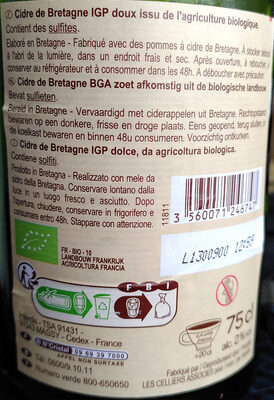Cidre Bio DOUX gazéifié - Carrefour Bio - 75 cl
Some of the data for this product has been provided directly by the manufacturer Carrefour.
Barcode: 3560071246747 (EAN / EAN-13)
Common name: Cidre doux issu de l'agriculture biologique.
Quantity: 75 cl
Packaging: Bottle cap, Metal, Glass, Bottle, Cork, Green Glass, Wire-cage-and-cap
Brands: Carrefour Bio, Carrefour
Categories: Beverages, Alcoholic beverages, Ciders, Sweet ciders, fr:Cidre de Bretagne
Labels, certifications, awards:
Organic, EU Organic, Not advised for specific people, EU Agriculture, FR-BIO-10, French agriculture, Not advised for pregnant women, PGI, AB Agriculture Biologique, Triman




Origin of the product and/or its ingredients: Fabriqué à partir de pommes origine France.
Origin of ingredients: France, Brittany
Producer: Le premier chiffre du numéro de lot correspond au site de fabrication : 1 pour le site de Condé sur Vire: EMB 50139 - 0 pour le site de Pleudihen sur Rance : EMB 22197C.
Manufacturing or processing places: France, Bretagne
Traceability code: EMB 501390 - Condé-sur-Vire (Manche, France)
Link to the product page on the official site of the producer: https://www.carrefour.fr/p/cidre-igp-bre...
Stores: Carrefour, carrefour.fr
Matching with your preferences
Other information
Conservation conditions: Avant ouverture, à conserver dans un endroit frais et sec. Après ouverture, à reboucher, à conserver au réfrigérateur et à consommer dans les 48h.
Customer service: Interdis - TSA 91431 - 91343 MASSY Cedex - France
Report a problem
Data sources
Product added on by kiliweb
Last edit of product page on by org-carrefour.
Product page also edited by chevalstar, driveoff, jolesh, mairoluin, openfoodfacts-contributors, roboto-app, segundo, teolemon, yuka.WTZWUU1hZ3pqYU1JcDg4UjhnalkwZXhleDVxeGVEdXNLclZJSUE9PQ.












